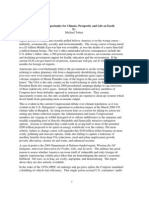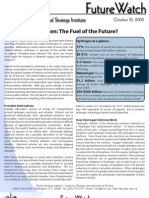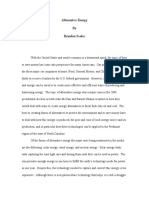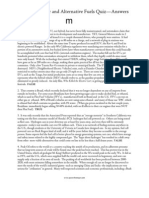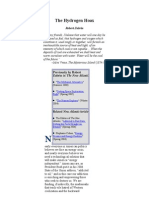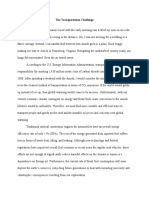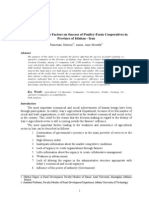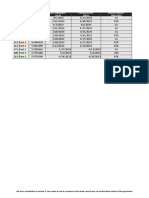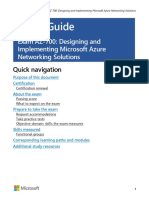Fried Mango Green Navy
Fried Mango Green Navy
Uploaded by
caritowebCopyright:
Available Formats
Fried Mango Green Navy
Fried Mango Green Navy
Uploaded by
caritowebCopyright
Available Formats
Share this document
Did you find this document useful?
Is this content inappropriate?
Copyright:
Available Formats
Fried Mango Green Navy
Fried Mango Green Navy
Uploaded by
caritowebCopyright:
Available Formats
The U.S.S. Prius - NYTimes.
com
Page 1 of 3
Reprints This copy is for your personal, noncommercial use only. You can order presentation-ready copies for distribution to your colleagues, clients or customers here or use the "Reprints" tool that appears next to any article. Visit www.nytreprints.com for samples and additional information. Order a reprint of this article now.
December 18, 2010
The U.S.S. Prius
By THOMAS L. FRIEDMAN
As I was saying, the thing I love most about America is that theres always somebody here who doesnt get the word and they go out and do the right thing or invent the new thing, no matter whats going on politically or economically. And what could save Americas energy future at a time when a fraudulent, anti-science campaign funded largely by Big Oil and Big Coal has blocked Congress from passing any clean energy/climate bill is the fact that the Navy and Marine Corps just didnt get the word. God bless them: The Few. The Proud. The Green. Semper Fi. Spearheaded by Ray Mabus, President Obamas secretary of the Navy and the former U.S. ambassador to Saudi Arabia, the Navy and Marines are building a strategy for outgreening Al Qaeda, out-greening the Taliban and out-greening the worlds petrodictators. Their efforts are based in part on a recent study from 2007 data that found that the U.S. military loses one person, killed or wounded, for every 24 fuel convoys it runs in Afghanistan. Today, there are hundreds and hundreds of these convoys needed to truck fuel to run air-conditioners and power diesel generators to remote bases all over Afghanistan. Mabuss argument is that if the U.S. Navy and Marines could replace those generators with renewable power and more energy efficient buildings, and run its ships on nuclear energy, biofuels and hybrid engines, and fly its jets with bio-fuels, then it could out-green the Taliban the best way to avoid a roadside bomb is to not have vehicles on the roads and out-green all the petro-dictators now telling the world what to do. Unlike the Congress, which can be bought off by Big Oil and Big Coal, it is not so easy to tell the Marines that they cant buy the solar power that could save lives. I dont know what the final outcome in Iraq or Afghanistan will be, but if we come out of these two wars with a Pentagon-led green revolution, I know they wont be a total loss. Wars that were driven
http://www.nytimes.com/2010/12/19/opinion/19friedman.html?ref=general&src=me...
20/12/2010
The U.S.S. Prius - NYTimes.com
Page 2 of 3
partly by our oil addiction end up forcing us to break our oil addiction? Wouldnt that be interesting? Jackalyne Pfannenstiel, the assistant secretary of the Navy for energy, installations and environment, used to lead the California Energy Commission. She listed for me whats going on: On April 22, Earth Day, the Navy flew a F/A-18 Super Hornet fighter jet powered by a 50-50 blend of conventional jet fuel and camelina aviation biofuel made from pressed mustard seeds. It flew at Mach 1.2 and has since been tested on biofuels at Mach 1.7 without a hiccup. I loved the quote in Biofuels Digest from Scott Johnson, general manager of Sustainable Oils, which produced the camelina: It was awesome to watch camelina biofuel break the sound barrier. The Navy will use only third generation biofuels. That means no ethanol made from corn because it doesnt have enough energy density. The Navy is only testing fuels like camelina and algae that do not compete with food, that have a total end-to-end carbon footprint cleaner than fossil fuels and that can be grown in ways that will ultimately be cheaper than fossil fuels. In October, the Navy launched the U.S.S. Makin Island amphibious assault ship, which is propelled by a hybrid gas turbine/electric motor. On its maiden voyage from Mississippi to San Diego, said Mabus, it saved $2 million in fuel. In addition, the Navy has tested its RCB-X combat boat on a 50-50 blend of algae and diesel, and it has tested its SH-60 helicopter on a similar biofuel blend. Meanwhile, the Marines now have a green forward operating base set up in Helmand Province in Afghanistan that is testing in the field everything from LED lights in tents to solar canopies to power refrigerators and equipment to see just how efficiently one remote base can get by without fossil fuel. When you factor in all the costs of transporting fuel by truck or air to a forward base in Afghanistan that is, guarding it and delivering it over mountains a single gallon of gasoline could cost up to $400 once it finally arrives, Mabus said. The Navy plans in 2012 to put out to sea a Great Green Fleet, a 13-ship carrier battle group powered either by nuclear energy or 50-50 blends of biofuels and with aircraft flying on 5050 blends of biofuels.
http://www.nytimes.com/2010/12/19/opinion/19friedman.html?ref=general&src=me...
20/12/2010
The U.S.S. Prius - NYTimes.com
Page 3 of 3
Mabus has also set a goal for the Navy to use alternative energy sources to provide 50 percent of the energy for all its war-fighting ships, planes, vehicles and shore installations by 2020. If the Navy really uses its buying power when buying power, and setting building efficiency standards, it alone could expand the green energy market in a decisive way. And, if Congress will simply refrain from forcing the Navy to use corn ethanol or liquid coal neither of which are clean or efficient, but are located in many Congressional districts we might really get a green revolution in the military. That could save lives, money and the planet, and might even help us win or avoid the next war. Go Navy!
http://www.nytimes.com/2010/12/19/opinion/19friedman.html?ref=general&src=me...
20/12/2010
You might also like
- BS EN 55032-2015 Plus Cor2016 Plus A11-2020Document110 pagesBS EN 55032-2015 Plus Cor2016 Plus A11-2020flaviopoNo ratings yet
- Selling Aint HardDocument147 pagesSelling Aint HardC.J. FuertesNo ratings yet
- Air Force Alternative FuelsDocument2 pagesAir Force Alternative FuelsFernando LopezNo ratings yet
- Aviation Biofuel Is A Growing IndustryDocument6 pagesAviation Biofuel Is A Growing IndustryCarl FreerNo ratings yet
- Green Transport Portfolio 2Document8 pagesGreen Transport Portfolio 2api-381911612No ratings yet
- Week 2 IlabDocument3 pagesWeek 2 IlabMuadz Nurullah AbdurrahmanNo ratings yet
- Add Climate Havoc To War Crimes: Pentagon's Role in Global CatastropheDocument12 pagesAdd Climate Havoc To War Crimes: Pentagon's Role in Global CatastropheWorkers.orgNo ratings yet
- Will - Being Green at Ben and JerryDocument2 pagesWill - Being Green at Ben and JerryTrevor BullardNo ratings yet
- Plan: The United States Federal Government Should Develop Space Based Solar PowerDocument17 pagesPlan: The United States Federal Government Should Develop Space Based Solar Powerjjun96No ratings yet
- HydrogenDocument20 pagesHydrogenNeelNo ratings yet
- 1.1.panos 444Document34 pages1.1.panos 444Lawrence Martin LausNo ratings yet
- The Climate For ChangeDocument3 pagesThe Climate For ChangeTramp7No ratings yet
- Titanic and Hindenburg ExtractDocument33 pagesTitanic and Hindenburg ExtractSam KofaltNo ratings yet
- Win-Win Opportunity For Climate Prosperity and Life Op-Ed 07-01-08Document4 pagesWin-Win Opportunity For Climate Prosperity and Life Op-Ed 07-01-08Michael P TottenNo ratings yet
- 0510 GsifuturewatchhydrogenDocument3 pages0510 GsifuturewatchhydrogenRattanDeep SinghNo ratings yet
- Alternative Energy PaperDocument6 pagesAlternative Energy PaperBrandon ScalesNo ratings yet
- The Hydrogen EconomyDocument9 pagesThe Hydrogen EconomyVP JonNo ratings yet
- Practical Steps Toward A Carbon-Free Maritime Industry: Updates On Fuels, Ports, and TechnologyDocument7 pagesPractical Steps Toward A Carbon-Free Maritime Industry: Updates On Fuels, Ports, and TechnologyThe International Council on Clean TransportationNo ratings yet
- Hoja de Seguridad HidrogenoDocument32 pagesHoja de Seguridad HidrogenoMichel LopezNo ratings yet
- Title Xi - Aff - 7wkhkbppDocument240 pagesTitle Xi - Aff - 7wkhkbppMikey HolohanNo ratings yet
- Steering a New Course: Transportation, Energy, and the EnvironmentFrom EverandSteering a New Course: Transportation, Energy, and the EnvironmentNo ratings yet
- Fuel Cell Green Power Los Alamos ReviewDocument36 pagesFuel Cell Green Power Los Alamos Reviewale_xxx123No ratings yet
- Artykuł1Document6 pagesArtykuł1Klaudia TrelińskaNo ratings yet
- One World Democracy09Document11 pagesOne World Democracy0975599874097No ratings yet
- Chemistry Intercultural Project 2024Document12 pagesChemistry Intercultural Project 2024vaniiee08No ratings yet
- The Captain's Guide to Alternative Energy Afloat - Part 1 of 2: Marine Electrical Systems, Water Generators, Solar Power, Wind Turbines, Marine BatteriesFrom EverandThe Captain's Guide to Alternative Energy Afloat - Part 1 of 2: Marine Electrical Systems, Water Generators, Solar Power, Wind Turbines, Marine BatteriesNo ratings yet
- Z Biocombustivel, Ciencia Ou FicçãoDocument2 pagesZ Biocombustivel, Ciencia Ou FicçãorafakillsNo ratings yet
- The Green Car and Alternative Fuels QuizDocument5 pagesThe Green Car and Alternative Fuels QuizMarcus Skookumchuck VanniniNo ratings yet
- English Class Essay OutlineDocument5 pagesEnglish Class Essay OutlineRodgerSeagraves100% (1)
- Environmental and Social Issues Concerned With Hybrid Cars PDFDocument120 pagesEnvironmental and Social Issues Concerned With Hybrid Cars PDFismayilc100% (1)
- Aerion AS2 A 5 Billion Supersonic SagaDocument11 pagesAerion AS2 A 5 Billion Supersonic Sagaflateric74@yandex.ruNo ratings yet
- The Hydrogen HoaxDocument22 pagesThe Hydrogen HoaxChris LeNo ratings yet
- Debunking The Green Myth: Perma CreteDocument5 pagesDebunking The Green Myth: Perma CreteZeb'sNo ratings yet
- 0926BUS EconsnapshotDocument1 page0926BUS EconsnapshotThe Dallas Morning NewsNo ratings yet
- Paper Project 3Document11 pagesPaper Project 3aejiastaNo ratings yet
- Conservation Watch: The Gulf Oil Spill - A Sea Change in The Making?Document24 pagesConservation Watch: The Gulf Oil Spill - A Sea Change in The Making?The Garden Club of AmericaNo ratings yet
- Natural GasDocument2 pagesNatural GascalebprofittNo ratings yet
- Clean Energy Nation: Freeing America from the Tyranny of Fossil FuelsFrom EverandClean Energy Nation: Freeing America from the Tyranny of Fossil FuelsRating: 5 out of 5 stars5/5 (2)
- Pipelines-Rail-Truck ComparisonDocument6 pagesPipelines-Rail-Truck Comparisondownload crackan100% (1)
- Energy Independence Myths and SolutionsDocument2 pagesEnergy Independence Myths and SolutionsAdam KhanNo ratings yet
- Double HullDocument10 pagesDouble HullLea BrooklynNo ratings yet
- Harvest the Wind: America's Journey to Jobs, Energy Independence, and Climate StabilityFrom EverandHarvest the Wind: America's Journey to Jobs, Energy Independence, and Climate StabilityRating: 4 out of 5 stars4/5 (1)
- Ielts Mock TestDocument59 pagesIelts Mock TestIelts Guru ReviewNo ratings yet
- Emily Thomas English PortfolioDocument10 pagesEmily Thomas English Portfolioemmyjay12No ratings yet
- Clip, Clop, Clip, Clop.: The Transportation ChallengeDocument4 pagesClip, Clop, Clip, Clop.: The Transportation Challengefwl5031No ratings yet
- The Role of Dams in Sustainable DevelopmentDocument6 pagesThe Role of Dams in Sustainable DevelopmentSEP-PublisherNo ratings yet
- Definition AssignmentDocument5 pagesDefinition AssignmentRachel KaneNo ratings yet
- The Future of OilDocument7 pagesThe Future of OilMelissa WilsonNo ratings yet
- The Captain's Guide to Alternative Energy Afloat - Part 2 of 2: Marine Electrical Systems, Water Generators, Solar Power, Wind Turbines, Marine BatteriesFrom EverandThe Captain's Guide to Alternative Energy Afloat - Part 2 of 2: Marine Electrical Systems, Water Generators, Solar Power, Wind Turbines, Marine BatteriesNo ratings yet
- Apes in The News The Plan To Power The Us With 100 Percent Clean Energy Is Almost All WindDocument3 pagesApes in The News The Plan To Power The Us With 100 Percent Clean Energy Is Almost All Windapi-250807061No ratings yet
- Power to the People: How the Coming Energy Revolution Will Transform an Industry, Change Our Lives, and Maybe Even Save the PlanetFrom EverandPower to the People: How the Coming Energy Revolution Will Transform an Industry, Change Our Lives, and Maybe Even Save the PlanetRating: 4 out of 5 stars4/5 (4)
- Companies Should Invest in Hydrogen Fuel CellDocument5 pagesCompanies Should Invest in Hydrogen Fuel CellMohammad Abdul AzizNo ratings yet
- GlenbrookNorth CaRo Aff Spartan Green and Gold Round 1Document45 pagesGlenbrookNorth CaRo Aff Spartan Green and Gold Round 1tim lewisNo ratings yet
- Reading Passage 1: IELTS Mock Test 2020 OctoberDocument19 pagesReading Passage 1: IELTS Mock Test 2020 OctoberEDWIN M.PNo ratings yet
- EAPP ReportDocument23 pagesEAPP ReportSemi SenNo ratings yet
- Sam Tomlinson English 1201Document5 pagesSam Tomlinson English 1201api-534376573No ratings yet
- Advocacy PaperDocument22 pagesAdvocacy Paperapi-385106556No ratings yet
- Applsci 09 02296 PDFDocument17 pagesApplsci 09 02296 PDFgsNo ratings yet
- 2016 Book WhenTrucksStopRunningDocument136 pages2016 Book WhenTrucksStopRunningSen MeiNo ratings yet
- 1 Nature and Scope of JurisprudenceDocument5 pages1 Nature and Scope of JurisprudencenortheyehimanshuNo ratings yet
- Acc 150 Merged CompleteDocument94 pagesAcc 150 Merged Completedelossantosellamae838No ratings yet
- Nov23 Hydraulics 01 06 Nov 2023Document16 pagesNov23 Hydraulics 01 06 Nov 2023Jayson Mari100% (1)
- Interdiciplinary Lesson PlanDocument19 pagesInterdiciplinary Lesson Planapi-350294269No ratings yet
- Dry-Block Calibrator Uncertainties - Mike Hirst, 2018-03-28 PDFDocument28 pagesDry-Block Calibrator Uncertainties - Mike Hirst, 2018-03-28 PDFCALIBRATION TRACKINGNo ratings yet
- EH 0047 HRCompliance-MY Guide V4 2023Document23 pagesEH 0047 HRCompliance-MY Guide V4 2023Siti NorainNo ratings yet
- Timken Induction Heater VHIN900Document2 pagesTimken Induction Heater VHIN900grupa2904No ratings yet
- Region 2: Provinces AreDocument2 pagesRegion 2: Provinces AreMariNo ratings yet
- Lecture On Data Collection - Obsevation MethodDocument25 pagesLecture On Data Collection - Obsevation MethodRaghavendra NadgaudaNo ratings yet
- Index Sa ChemistryDocument2 pagesIndex Sa ChemistryReiNo ratings yet
- Solid-State Circuits Magazine IEEE - Volume 9 - Issue 3Document68 pagesSolid-State Circuits Magazine IEEE - Volume 9 - Issue 3Paul Shine EugineNo ratings yet
- Iris Valencia RS 6 Week 1 2021Document4 pagesIris Valencia RS 6 Week 1 2021IrisNo ratings yet
- Specs - Geotechnical InvestigationsDocument9 pagesSpecs - Geotechnical InvestigationsvivekNo ratings yet
- Indian Depository Receipts (IDR)Document14 pagesIndian Depository Receipts (IDR)Syed IliyasNo ratings yet
- Vedanta Sandesh - Nov 2020Document58 pagesVedanta Sandesh - Nov 2020Swami AtmanandaNo ratings yet
- Tesla Air Conditioner User Manual EX YUDocument60 pagesTesla Air Conditioner User Manual EX YUIvanaKovacevicExIvanovicNo ratings yet
- Norsok M 122 Ed 2012 Cast Structural Steel - CompressDocument20 pagesNorsok M 122 Ed 2012 Cast Structural Steel - CompressAndy TaylorNo ratings yet
- DesignDocument820 pagesDesignPatricia Inovero Manuel100% (1)
- Maurice Hauriou - Harvard Law Rev - 1918Document10 pagesMaurice Hauriou - Harvard Law Rev - 1918fvillarolmedoNo ratings yet
- Solidworks Plastics - Solidworks 2015 TrainingDocument217 pagesSolidworks Plastics - Solidworks 2015 TrainingNaygunsNo ratings yet
- SNG From Pet CokeDocument6 pagesSNG From Pet CokeSarath Jose KNo ratings yet
- Kpi Iran Poultry FarmDocument13 pagesKpi Iran Poultry FarmIan YongNo ratings yet
- Republic of The Philippines Pablo Borbon Main II, Batangas City WWW - Batstate-U.edu - PH Tel. No. (043) 425-0139 Loc. 118Document10 pagesRepublic of The Philippines Pablo Borbon Main II, Batangas City WWW - Batstate-U.edu - PH Tel. No. (043) 425-0139 Loc. 118Janpherson BellecaNo ratings yet
- Chapter Wise Question BankDocument57 pagesChapter Wise Question Bank123nishandhakall.dNo ratings yet
- FRM - Violation - Report (For DM) 08052023 - CompileDocument17 pagesFRM - Violation - Report (For DM) 08052023 - Compileahmad zakariaNo ratings yet
- AZ-700 StudyGuide ENU v125 2.1Document9 pagesAZ-700 StudyGuide ENU v125 2.1lis infraopsNo ratings yet
- Industrial Pharmacy 7th Sem Important Questions B Pharm Shahruddin KhanDocument35 pagesIndustrial Pharmacy 7th Sem Important Questions B Pharm Shahruddin Khanammarahmad882002No ratings yet
- Basic Questions About The Millennium, Part 2: The Issue of Dispensational PremillennialismDocument12 pagesBasic Questions About The Millennium, Part 2: The Issue of Dispensational PremillennialismBrendan Paul Valiant100% (1)













